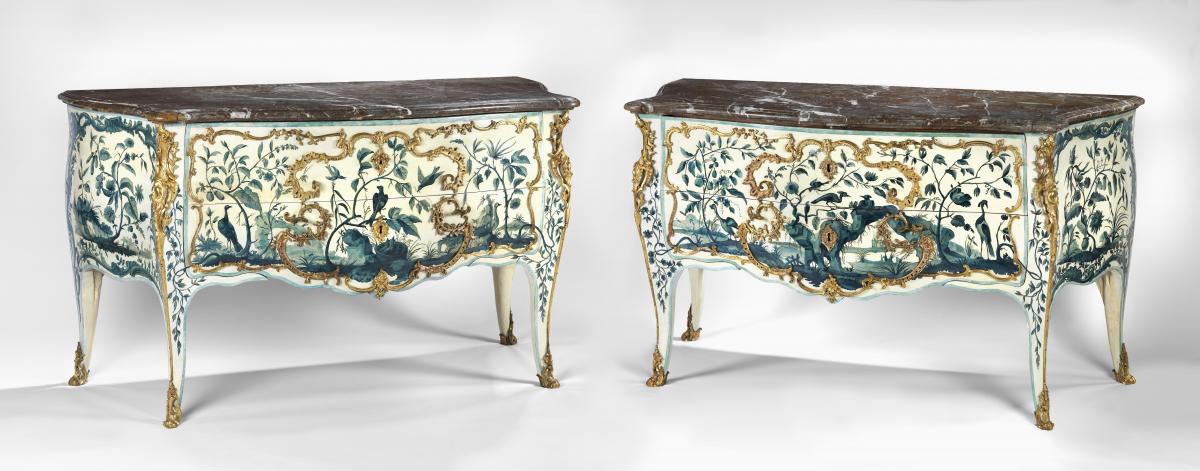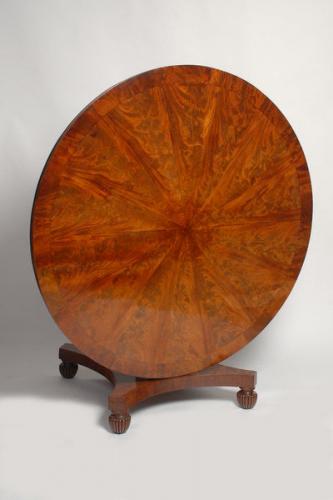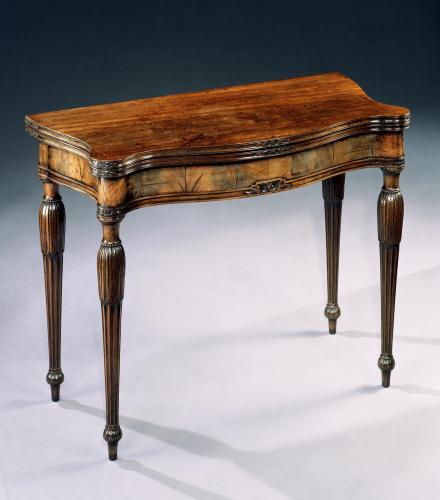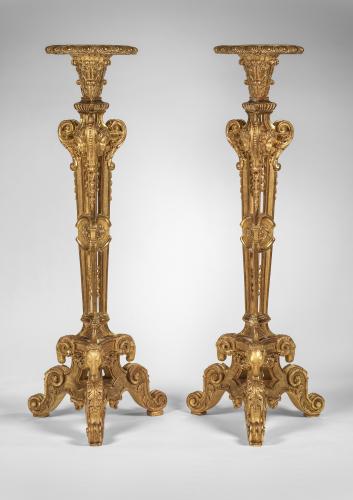












Price on application
This object is eligible for a Certificate of BADA Provenance
The BADA Standard
- Since 1918, BADA has been the leading association for the antiques and fine art trade
- Members are elected for their knowledge, integrity and quality of stock
- Our clients are protected by BADA’s code of conduct
- Our dealers’ membership is reviewed and renewed annually
- Bada.org is a non-profit site: clients deal directly with members and they pay no hidden fees
Of serpentine rectangular form standing on four cabriole legs, which support Marbre de Rance tops of conforming shape with double mouldings. The white lacquer surfaces profusely painted with a papiers des Indes decoration of birds, rocks, foliage and fruits. The fronts with narrow painted borders, recently discovered under layers of yellow lacquer. They are richly mounted with ormolu mounts of the highest quality. The sides with sumptuously painted trompe l’œil rococo borders resembling carved framing. Although stamped by Chevallier the commodes were almost certainly made by Mathieu Criaerd and the Vernis Martin Lacquer painted by Alexis Peyrotte.
Charles Chevalier (1703-1771) and Mathieu Criaerd (1689-1776)
The Chevalier Dynasty of Parisian ébénistes constitutes one the longest running family of cabinet makers of 18th. Century France beginning with Mathieu, who with his wife Anne Martin had four sons and four daughters The eldest of these four sons was Jean -Mathieu I (1694-1768); he was the brother-in-law of the vernisseur, Guillaume Martin (1689-1749) .[i] The next was Jean François, who went to Potsdam. Then came Jean Mathieu (1694-1768) who had a son, Jean-Mathieu II and a daughter, Suzanne, who married Antoine-Mathieu Criaerd , the son of Mathieu Criaerd and the maker of Madame de Mailly’s blue and white lacquer commode in the Louvres (see below). Jean-Mathieu Chevalier was a very successful ébéniste and marchand.
Finally to Mathieu’s youngest son, Charles His younger brother, Charles had a different atelier in the Rue du Bac (from 1739) and was received as a maítre before 1738 and a juré in 1744. Calin Demetrescu suggests, however, that Charles’s business was run along very different lines to that of his elder brothers and nephew, Antoine Mathieu Criaerd, who took the additional name, Chevalier on the death of his uncle in 1771. The valuation of his stock alone was valued at 10,000 livres and included not less than 105 commode carcasses in various states of completion, 16 encoignures, 60 secretaires and countless other things. Interestingly, there are no work benches at his death! He certainly trained as an ébéniste and would have to pass the rigours of examination by the Guild and, as an examiner (Juré) himself. In the 1769 Almanach d’Indication…ou de Vrai Mérite, he is described as being one of the principal exponents of his craft. He had considereable contacts within his Guild, Gaspard Coulon, his father-in-law, being the Principal. He was related, too, to the Saunier family and, of course to the Criaerds. However, he appears to have been prosperous in his own right and counted among his clients some of the highest echelons of acristocracy living in nearby Faubourg Saint Germain. As a marchand , he would be able to bring together several disciplines. It is, of course possible that Charles Chevalier supplied the commodes to Madame de Pompadour but there is no evidence. Her principal marchand-mercier, Lazare Duvaux is much more likely to have supplied them but unfortunately the second volume of his Livre-Journal, (1748-1758) only begins on the 17th. September 1748 when the furnishing of the Château de la Celle de Saint Cloud was well under way. It would now appear that it is much more likely that Hebert supplied them.
Mathieu Criaerd (1689-1776)
The younger brother of André Criaerd, he produced furniture of the very highest quality, mostly in the Louis XV style. Some at the beginning of his career, which spanned some thirty years, are in a late Régence style but he seems not to have particularly adopted the transitional style at the end of the reign. Although much of the marquetry is of geometric form aux bois des Indes, with few months, there exists a large group of very similar form (see below) luxuriously mounted with gilt bronzes of the most exquisite form and finish. They are used on geometric, floral and oriental lacquer surfaces, one having been delivered by Hébert for the Cabinet of the Dauphin in 1747. Hebert also supplied the famous suite of furniture for Madame de Mailly at the Château de Choisy, which is recorded in his journal on the 30th. October 1742.
Hébert describes Criaerd as an ébéniste de couleur which implies that he made a number of these pieces of furniture, although he could also have been referring to genuine oriental lacquer pieces and those made in that manner. Some may have started off life as blue and white furniture and then been stripped and replaqué with veneers. There are a number of examples of this practice in Lazare Duvaux’s Journals, such was the ephemeral nature of style in 18th. Century France. These four examples are of exceptional rarity; a pair is unheard of !
Sophie Mouquin has suggested that the shape, which is used by other makers such as BVRB, Dubois, Jean Desforges and Migeon IV are to a design by Hébert himself.
While bearing the stamp of Charles Chevalier (1700-1771), the actual maker of these commodes is, without doubt, Mathieu Criaerd (1689-1776). His stamp is simply M Criard and he was not only related to him by marriage but was also his colleague.
COMMENTARY:
The Comtesse de Mailly, received the blue and white furniture at the Château de Choisy in 1742. She was to occupy the position of maitresse-en-titre for a short time only[i]. Two of her sisters followed in succession, the Marquise de Vintimille, who died giving birth to the King’s son, the Comte de Luc. M de Mailly returned to look after the baby but was quickly supplanted by another sister, the Duchesse de Châteauroux. She too died young in 1744. The King was heartbroken but found the usual intrigues of his aristocratic mistresses in seeking wealth and power tiresome. It was assumed that he would take on the fourth sister, Madame de Lauragais. While he liked her company, it was not to be and nor would he go back to M. de Mailly. The King’s mistresses had always been drawn from noble families; a bourgoisewas unthinkable, nor could they be formally presented to the King and Queen.
In February of 1745, to celebrate the marriage of the Dauphin a whole series of masked balls was organised. One of these took place in the King’s riding school at Versailles, which was where the King probably met Madame de Pompadour for the first time.
Madame de Pompadour (1721-1764)
She was fortunate in having for her Godfather, Jean Pâris de Montmartel (1690-1760), the youngest of the fabulously wealthy banking brothers who virtually ran the economy of France and second only to the King in wealth. Born Jeanne-Antoinette Poisson (meaning fish!) she was very early on taken on, along with her brother Abel (later the Marquis de Marigny) by Charles François le Normant de Tournehem. Very unusually for a girl, she was exceptionally well taught. By the time she was of marriageable age ‘Reinette’ as she was known, was finding it difficult to be married, as her bourgeois parents had little money. De Tournehem offered an enormous dowry to his nephew, Monsieur Normont d’Etioles to persuade him to marry her. The young couple were to live with him in his house in Paris and the pretty Château d’Etioles in the forest of Sénart. He agreed, too, to pay all their bills.
Madame d’Etioles was blessed with great talents; she could dance, act and sing beautifully and play the clavichord perfectly. She liked natural history and was an enthusiastic gardener and botanist. Her knowledgeable interest in the famous philosophes of her day such as Voltaire, made her a sort-after guest at the salons in Paris. She had a famously intelligent wit and her charm and good nature were legendary. Very soon she had her own salon and acted as hostess to M. de Tournhem. She was a superb housekeeper and endowed with the most exquisite taste. She quickly came to know members of the Court, including the Comtesse de Mailly who spoke to the King about her attributes.
The King knew her by sight as he loved to hunt in the Forest of Sénart, close to the favourite of his houses, The Château de Choisy, an old hunting lodge which had been altered by his architect, Jacques Ange IV Gabriel. Here the King could relax with a small group of friends without being disturbed even by servants; a remarkable mechanical table saw to that.[i]Although only the oldest noble families, dating from before 1400, could hunt with the King, neighbours could follow in fast calèches. The King thus knew her by sight from 1741 until the fateful Ball in early 1745. The attraction was instant and although hesitant at first to install her as his mistress, she was quickly given the small former apartment of Madame de Mailly at Versailles. Very soon these became ever more palatial; Madame de Châteauroux’s large apartments at Versailles and Fontainebleau came next.
The Marquise de Pompadour, as she quickly became, was given the estate of Pompadour which carried with it a Marquisate, long in abeyance.[ii] She was thus now an aristocrat and able to be presented at Court. The King showered money on her which enabled her to acquire and decorate her houses in her faultless taste; she hated anything banal. She often advised the King in the decoration of his own Châteaux. Until he met her, this shy, intelligent man occupied his time with politics and hunting. He had an innate naturally good taste and a thirst for knowledge. Madame de Pompadour brought all of this to him. Houses became something of a hobby for them both. Too private and reserved to approach the Marchands Mercier himself, she acted as his go-between. Her principal Marchand Mercier was Lazare Duvaux (1703-1758).
Most of the houses she owned had already been built. Crécy was the first of her own homes though considerably enlarged by her favourite architect, Jean II Lassurance. All the houses were fairly close to each other; the roads were too poor to enable the Court to travel long distances. An itinerary was set by the King at Christmas which only death could interrupt or alter: Choisy, Marly, La Muette, Trianon and, later Bellevue, Crécy, St. Hubert and the Petit Trianon. The longer journeys to Compiègne and Fontainebleau required considerable expense. She also liked small Hermitages in both these places (as well as Versailles) where she created exquisitely scented gardens and in which the King could spend days alone with her. The one at Versailles is altered almost beyond all recognition; that at Compiègne is completely gone; only that at Fontainebleau has survived with an interior which she would have recognised (see below). This is a blue and white interior painted with garlands of flowers and birds designed by Alexis Peyrotte and also certainly painted by him. Having drawn designs for the silk manufactories of Lyons, he came to the attention of the Controleur Générale des Meubles de la Couronne, the Marquis de Fontanieu who invited him to join the workshops of the Crown in 1747 (see below).
Another small Château de Brinborion was followed rapidly by Montretout near Saint Cloud. She must have known the small Château de Celle, so called because of its proximity to the ancient monastery of Saint Cloud. This was a Château belonging to François Gabriel Bachelier, a First Gentlemen of the Bedchamber and a close confidant of Louis XV. What had been a series of Medieval monastic buildings were pulled down and a new house, designed and built by Robert de Cotte, was put in its place.
The Château de la Celle de Saint Cloud
In 1748 the newly ennobled Marquise bought this elegant house and immediately renamed it the Château de la Celle de Saint Cloud in honour of the Merovingian Prince priest saint who had founded his monastery on a height overlooking the Seine in the 6th. Century.. It has been called that ever since. She added only a small wing to the left of the Cour d’Honneur. Some interiors remain to this day, but the Salon Bleu contains only one mirrored boiserie in the rococo manner and described in the 1975 Monuments Historiques dossier as originally blue and white. [i] The chimneypiece is described as gris moucheté.
[i] Salon Bleu Plan, Monuments Historiques
[i] This table rose from the basement fully laden . There were two so that the next course could be prepared. The King himself made the coffee.
[ii] Her husband had, very reluctantly agreed to a formal deed of separation. She bore the title in her own right.
[i] This unofficial title was given to the principal mistress of the King
Dimensions
158 x 68 x 91 HighThe BADA Standard
- Since 1918, BADA has been the leading association for the antiques and fine art trade
- Members are elected for their knowledge, integrity and quality of stock
- Our clients are protected by BADA’s code of conduct
- Our dealers’ membership is reviewed and renewed annually
- Bada.org is a non-profit site: clients deal directly with members and they pay no hidden fees
















